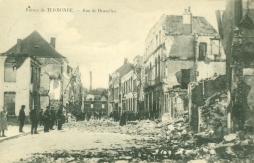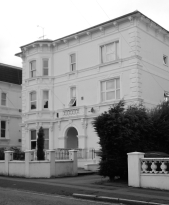Sunday 15th November was an important date in the calendar for the Belgian Community : it was (and still is) King’s Day – la Fete du Roi – Koningsdag – the King’s feast day [1] – and the day was celebrated in style in 1914 by the refugees and their hosts.

The Belgian flag was flown over most of the town’s public buildings, the Belgians themselves sported ribbons in their national colours of black, gold and red, and a full account of the proceedings was given in the local press the following Friday [2].
The day began with a Mass and the singing of patriotic hymns (though no mention on this occasion of a Te Deum) at St Augustine’s Catholic Church at which the huge congregation spilled out into Hanover Road. A special choir of Belgian refugees, including the Sisters of Mercy from Malines, was conducted by M. Denyn, and Canon Keatinge preached at length on the debt owed to the Belgian people by English Catholics whose forebears had taken refuge across the Channel during the reign of Elizabeth I.
After the service, the Belgians marched from the church to their temporary homes on Upper Grosvenor Road (at this early stage probably numbers 32 (Cintra House) and 47 (“the Belgian Hostel”), waving Belgian flags and singing their National Anthem, cheered on by crowds of local people who lined their way.
In the afternoon, the Belgian community gathered in the room lent to them for that purpose at the Constitutional Club on Calverley Road, to celebrate “their courageous King Albert”. M. Ernest KUMPS, provisional President of the newly-formed Belgian Club Albert, expressed their thanks for the “many kind attentions” they were receiving in Tunbridge Wells, and to the Mayor and the Corporation for the telegram they had sent King Albert to mark the occasion.
The next day a grand concert was held in the Pump Room [3] on The Pantiles, organised by Mr Frank HIRD [4] in the presence of the Mayor and Mayoress. Nearly 600 people, mostly Belgians, from all parts of the district, attended, according to the Kent & Sussex Courier, which described it as “a gathering unique in the history of the town”. The entire programme was in French with performances by local artistes who kindly gave their services – there was a short play in French [5], a ballet solo (which was so enjoyed it had to be repeated), recitations, piano solos – and an imitation of farmyard animals by a Miss Parbury.

Mr Hird received the ultimate accolade for the celebration when one of those attending shook him warmly by the hand and delared that it was “just like being at home”.
The occasion ended with the Allies’ National Anthems and was followed by refreshments : coffee, not tea – of course.
[1] King’s Day – 15th November is the feast day of both St Leopold and St Albert, and has been celebrated as King’s Day since 1866, during the reign of Leopold II. It is not a national public holiday, but is traditionally marked with a Te Deum at the Cathedral in Brussels, and a secular ceremony at the Belgian Federal Parliament.
[2] K & S Courier, Friday 20th November 1914
[3] The Pump Room was demolished in 1964 and replaced by the lovely Union House…
[4] Journalist and author Frank (Francis) HIRD was the adopted son and companion of sculptor Sir Ronald Gower of Mayo House on Mount Ephraim. Frank Hird was well known in the town for “organising amateur entertainments in aid of good works” (Kent & Sussex Courier, July 1915). In November 1914 he was helping out at West Hall VAD Hospital, and in October 1915 he became Secretary to the newly-opened Kingswood Park VAD Hospital. From 1917-1918 he was a Church Army Commissioner at the Front. Sir Ronald died in 1916 and Frank Hird in 1937. They are buried together at St Paul’s Rusthall.
[5]”Doctoresse et Couturier” by Julien Berr de Turique, a one-act play about a female doctor and a male dressmaker, who, after a series of misunderstandings, end up married – of course. The part of the dresssmaker was played by the Hon. Stephen Powys.









